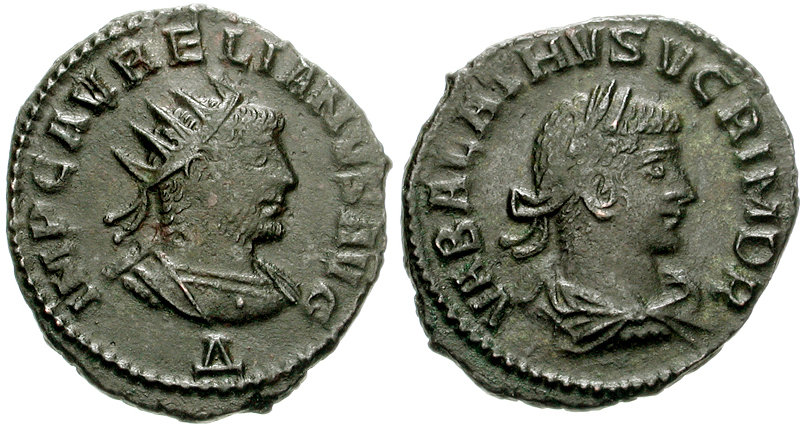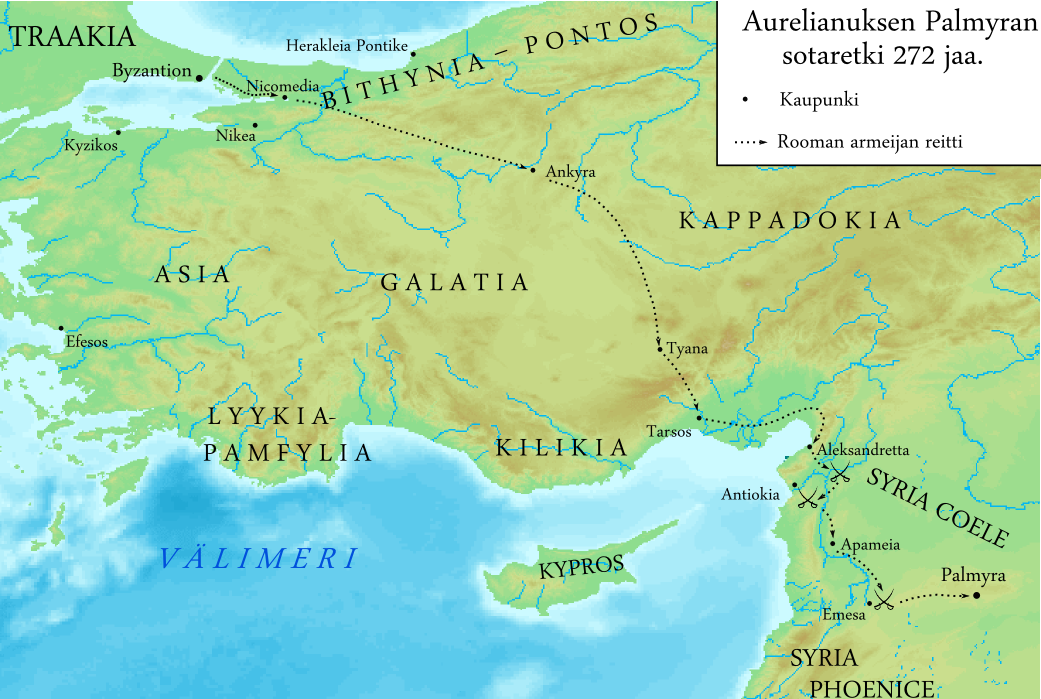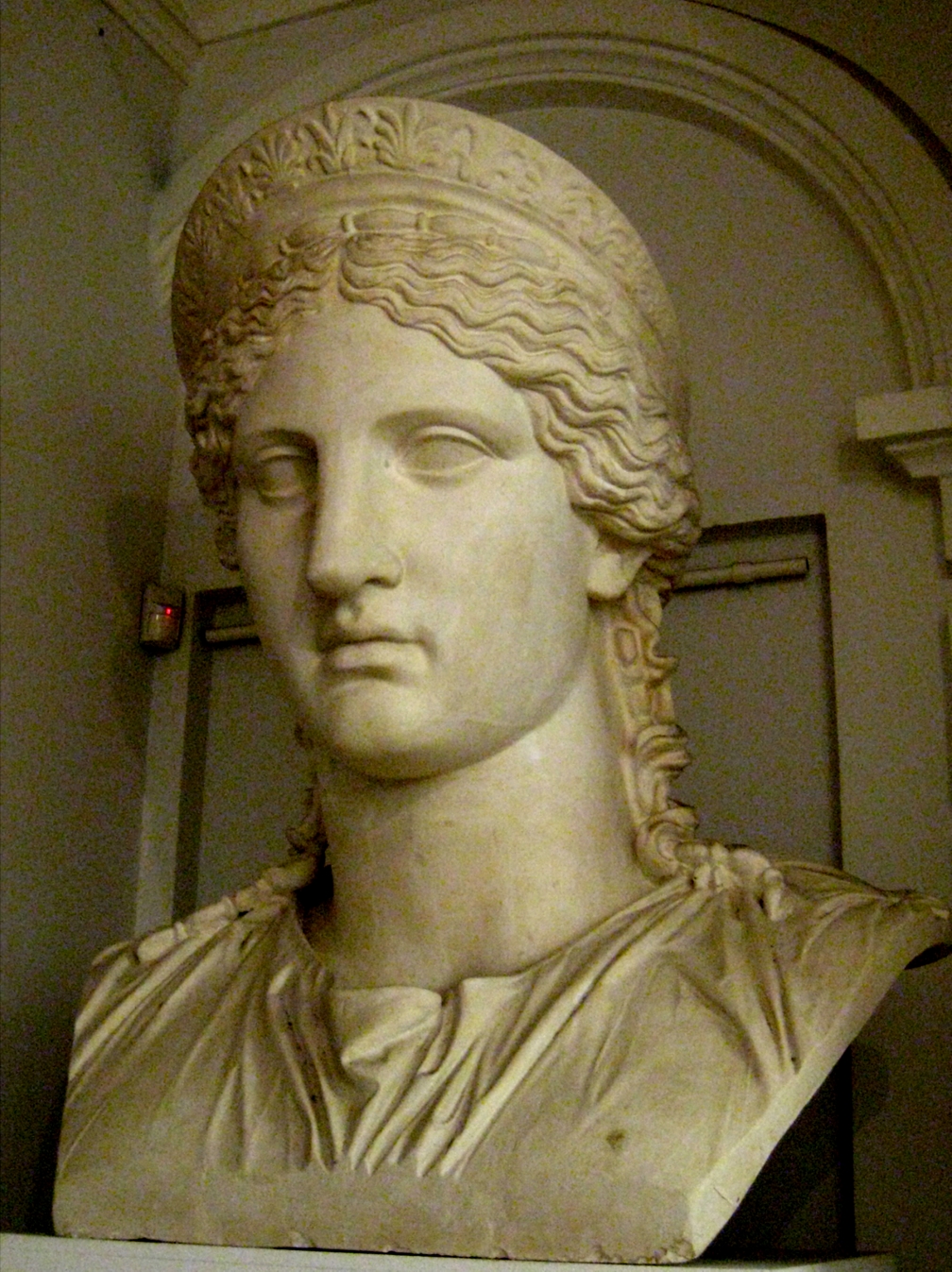|
Zenobia
Septimia Zenobia (Palmyrene Aramaic: , , vocalized as ; AD 240 – c. 274) was a third-century queen of the Palmyrene Empire in Syria. Many legends surround her ancestry; she was probably not a commoner and she married the ruler of the city, Odaenathus. Her husband became king in 260, elevating Palmyra to supreme power in the Near East by defeating the Sassanians and stabilizing the Roman East. After Odaenathus' assassination, Zenobia became the regent of her son Vaballathus and held de facto power throughout his reign. In 270, Zenobia launched an invasion that brought most of the Roman East under her sway and culminated with the annexation of Egypt. By mid-271 her realm extended from Ancyra, central Anatolia, to southern Egypt, although she remained nominally subordinate to Rome. However, in reaction to the campaign of the Roman emperor Aurelian in 272, Zenobia declared her son emperor and assumed the title of empress (declaring Palmyra's secession from Rome). The Romans were ... [...More Info...] [...Related Items...] OR: [Wikipedia] [Google] [Baidu] |
Palmyrene Empire
The Palmyrene Empire was a short-lived breakaway state from the Roman Empire resulting from the Crisis of the Third Century. Named after its capital city, Palmyra, it encompassed the Roman provinces of Syria Palaestina, Arabia Petraea, and Egypt, as well as large parts of Asia Minor. The Palmyrene Empire was ruled by Queen Zenobia, officially as regent for her son Vaballathus, who inherited the throne in 267 at age ten. In 270, Zenobia rapidly conquered most of the Roman east, attempting to maintain relations with Rome as a legitimate power. In 271, she claimed the imperial title for both herself and her son, fighting a short war with the Roman emperor Aurelian, who conquered Palmyra and captured Zenobia. A year later the Palmyrenes rebelled, which led Aurelian to destroy Palmyra. Despite its brief existence, the Palmyrene Empire is remembered for having been ruled by one of the most ambitious and powerful women in antiquity. It is also hailed in Syria, where it plays an impo ... [...More Info...] [...Related Items...] OR: [Wikipedia] [Google] [Baidu] |
Palmyra
Palmyra (; Palmyrene: () ''Tadmor''; ar, تَدْمُر ''Tadmur'') is an ancient city in present-day Homs Governorate, Syria. Archaeological finds date back to the Neolithic period, and documents first mention the city in the early second millennium BC. Palmyra changed hands on a number of occasions between different empires before becoming a subject of the Roman Empire in the first century AD. The city grew wealthy from trade caravans; the Palmyrenes became renowned as merchants who established colonies along the Silk Road and operated throughout the Roman Empire. Palmyra's wealth enabled the construction of monumental projects, such as the Great Colonnade, the Temple of Bel, and the distinctive tower tombs. Ethnically, the Palmyrenes combined elements of Amorites, Arameans, and Arabs. The city's social structure was tribal, and its inhabitants spoke Palmyrene Aramaic, a variety of Western Middle Aramaic, while using Koine Greek for commercial and diplomatic purp ... [...More Info...] [...Related Items...] OR: [Wikipedia] [Google] [Baidu] |
Odaenathus
Septimius Odaenathus (Palmyrene Aramaic: , , vocalized as ; ar, أذينة, translit=Uḏaina; 220 – 267) was the founder king ( ''Mlk'') of the Palmyrene Kingdom who ruled from Palmyra, Syria. He elevated the status of his kingdom from a regional center subordinate to Rome into a formidable state in the Near East. Odaenathus was born into an aristocratic Palmyrene family that had received Roman citizenship in the 190s under the Severan dynasty. He was the son of Hairan, the descendant of Nasor. The circumstances surrounding his rise are ambiguous; he became the lord (''ras'') of the city, a position created for him, as early as the 240s and by 258, he was styled a ''consularis'', indicating a high status in the Roman Empire. The defeat and captivity of Emperor Valerian at the hands of the Sassanian emperor Shapur I in 260 left the eastern Roman provinces largely at the mercy of the Persians. Odaenathus remained on the side of Rome; assuming the title of king, he led the P ... [...More Info...] [...Related Items...] OR: [Wikipedia] [Google] [Baidu] |
Vaballathus
Septimius Vaballathus (Palmyrene Aramaic: , , vocalized as ; ar, وهب اللات, translit=Wahb Allāt; 259 – c. 274 AD) was emperor of the Palmyrene Empire centred at Palmyra in the region of Syria. He came to power as a child under his regent mother Zenobia, who led a revolt against the Roman Empire and formed the independent Palmyrene Empire. Early life Lucius Julius Aurelius Septimius Vaballathus was born and raised in the city of Palmyra, an oasis settlement in the Syrian Desert in 259 to the king of kings of Palmyra, Odaenathus, and his second wife, queen consort of Palmyra, Zenobia. Vaballathus is the Latinized form of his Palmyrene name, ''Wahballāt'', "Gift of Allāt". As the Arabian goddess Allāt came to be identified with Athena, he used ''Athenodorus'' as the Greek form of his name. He had a half-brother, Hairan I, born from his father and another woman, who reigned as co-king of kings with his father, and a lesser-known brother, Hairan II. He also might h ... [...More Info...] [...Related Items...] OR: [Wikipedia] [Google] [Baidu] |
Aurelian
Aurelian ( la, Lucius Domitius Aurelianus; 9 September 214 October 275) was a Roman emperor, who reigned during the Crisis of the Third Century, from 270 to 275. As emperor, he won an unprecedented series of military victories which reunited the Roman Empire after it had nearly disintegrated under the pressure of barbarian invasions and internal revolts. Born in humble circumstances, near the Danube River, he entered the Roman military in 235, and climbed up the ranks. He went on to lead the cavalry of the emperor Gallienus, until Gallienus' assassination in 268. Following that, Claudius Gothicus became emperor until his own death in 270. Claudius' brother Quintillus ruled the empire for three months, before Aurelian became emperor. During his reign, he defeated the Alamanni after a devastating war. He also defeated the Goths, Vandals, Juthungi, Sarmatians, and Carpi. Aurelian restored the Empire's eastern provinces after his conquest of the Palmyrene Empire in 273. ... [...More Info...] [...Related Items...] OR: [Wikipedia] [Google] [Baidu] |
Septimius Antiochus
Septimius Antiochus (died after 273) was a Roman usurper in Syria during the 3rd century. In 272 AD Emperor Aurelian had defeated the breakaway Kingdom of Palmyra; its king Vaballathus and his mother Zenobia were in Roman captivity. In 273 AD another rebellion against Roman rule broke out in Palmyra. The rebels first approached Aurelian's governor Marcellinus to become emperor, but he pretended to consider the offer as he sent a letter to Aurelian warning of the rebellion. While the rebels were waiting they decided to elevate Septimius Antiochus, the reputed son of Zenobia, to the purple. Receiving Marcellinus's letter, the Emperor reacted quickly, and in the spring of 273 the city was brought back under Roman rule. Aurelian punished the city heavily, but allegedly spared Antiochus. Antiochus claimed to be descended from Queen Cleopatra VII Cleopatra VII Philopator ( grc-gre, Κλεοπάτρα Φιλοπάτωρ}, "Cleopatra the father-beloved"; 69 BC10 August 30&nbs ... [...More Info...] [...Related Items...] OR: [Wikipedia] [Google] [Baidu] |
List Of Palmyrene Monarchs
Below is a list of Palmyrene monarchs, the monarchs that ruled and presided over the city of Palmyra and the subsequent Palmyrene Empire in the 3rd century AD, and the later vassal princes of the Al Fadl dynasty which ruled over the city in the 14th century. House of Odaenathus Odaenathus, the lord of Palmyra, declared himself king before riding into battle against the Sassanians after news of the Roman defeat at Edessa reached him. This elevated Palmyra from a subordinate city to a de facto independent kingdom allied to Rome. Odaenathus later elevated himself to the title of King of Kings, crowning his son co-King of Kings in 263. The title was later passed to Vaballathus his son, before it was dropped for the title of King and later Emperor. Al Fadl AL, Al, Ål or al may stand for: Arts and entertainment Fictional characters * Al (''Aladdin'') or Aladdin, the main character in Disney's ''Aladdin'' media * Al (''EastEnders''), a minor character in the British soap opera * ... [...More Info...] [...Related Items...] OR: [Wikipedia] [Google] [Baidu] |
Hairan II
Hairan II was a Palmyrene prince, the son of king Odaenathus and, possibly, his second wife Zenobia. Seal RTP 736 The existence of Hairan was established by the discovery of a lead seal (code named RTP 736). The seal bears the images of two priests, one on each side. On one of the sides, the name of Odaenathus' son and successor Vaballathus was engraved under the image as a legend, while the name of Hairan was engraved on the other side. The name of Odaenathus was engraved on both sides. No name of a mother was engraved and the seal is undated. King Herodianus and Hairan II Odaenathus had another son, Hairan I, who appeared in different inscriptions dated from 251 AD onward. On a lead seal, the name of Septimius Herodianus, king of kings, appears; scholars argue whether Septimius Herodianus was Hairan I or II. The ''Augustan History The ''Historia Augusta'' (English: ''Augustan History'') is a late Roman collection of biographies, written in Latin, of the Roman emperor ... [...More Info...] [...Related Items...] OR: [Wikipedia] [Google] [Baidu] |
Egypt (Roman Province)
, conventional_long_name = Roman Egypt , common_name = Egypt , subdivision = Province , nation = the Roman Empire , era = Late antiquity , capital = Alexandria , title_leader = Praefectus Augustalis , image_map = Roman Empire - Aegyptus (125 AD).svg , image_map_caption = Province of Aegyptus in AD 125 , year_start = 30 BC , event_start = Conquest of Ptolemaic Kingdom , event1 = Formation of the Diocese , date_event1 = 390 , year_end = 641 , event_end = Muslim conquest , life_span = 30 BC – 641 AD , stat_year1 = 1st century AD , stat_pop1 = . , today = Egypt , p1 = Ptolemaic Kingdom , flag_p1 = Ptolemaic-Empire 200bc.jpg , s1 = Sasanian Egypt , flag_s1 = Derafsh Kaviani flag of the late Sassanid Empire.svg , s2 = Rashidun Caliphate , flag_s2 = Mohammad adil-Rashidun-empire-at-its-peak-close.PNG , demonym= Egypt ( ; ) was a subdivision of the Roman Empire fr ... [...More Info...] [...Related Items...] OR: [Wikipedia] [Google] [Baidu] |
List Of Augustae
(; plural ''Augustae''; el, αὐγούστα) was a Roman imperial honorific title given to empresses and honoured women of the imperial families. It was the feminine form of ''Augustus''. In the third century, ''Augustae'' could also receive the titles of ''Mater Senatus'' ("Mother of the Senate") and ''Mater Castrorum'' ("Mother of the Camp") and ''Mater Patriae'' ("Mother of the Fatherland"). The title implied the greatest prestige. ''Augustae'' could issue their own coinage, wear imperial regalia, and rule their own courts. Wife of Claudius, Agrippina was the first wife of the emperor in Roman history to receive the throne of Augusta, a position she held for the rest of her life, ruling with her husband and son. In the third century, Julia Domna was the first empress to receive the title combination "''Pia Felix Augusta''" after the death of her husband Septimius Severus, which may have implied greater powers being vested in her than what was usual for a Roman empress ... [...More Info...] [...Related Items...] OR: [Wikipedia] [Google] [Baidu] |
Ancyra
Ankara ( , ; ), historically known as Ancyra and Angora, is the capital of Turkey. Located in the central part of Anatolia, the city has a population of 5.1 million in its urban center and over 5.7 million in Ankara Province, making it Turkey's second-largest city after Istanbul. Serving as the capital of the ancient Celtic state of Galatia (280–64 BC), and later of the Roman province with the same name (25 BC–7th century), the city is very old, with various Hattian, Hittite, Lydian, Phrygian, Galatian, Greek, Persian, Roman, Byzantine, and Ottoman archeological sites. The Ottomans made the city the capital first of the Anatolia Eyalet (1393 – late 15th century) and then the Angora Vilayet (1867–1922). The historical center of Ankara is a rocky hill rising over the left bank of the Ankara River, a tributary of the Sakarya River. The hill remains crowned by the ruins of Ankara Castle. Although few of its outworks have survived, there are well ... [...More Info...] [...Related Items...] OR: [Wikipedia] [Google] [Baidu] |
Roman Citizenship
Citizenship in ancient Rome (Latin: ''civitas'') was a privileged political and legal status afforded to free individuals with respect to laws, property, and governance. Citizenship in Ancient Rome was complex and based upon many different laws, traditions, and cultural practices. There existed several different types of citizenship, determined by one's gender, class, and political affiliations, and the exact duties or expectations of a citizen varied throughout the history of the Roman Empire. History The oldest document currently available that details the rights of citizenship is the Twelve Tables, ratified c. 449 BC. Much of the text of the Tables only exists in fragments, but during the time of Ancient Rome the Tables would be displayed in full in the Roman Forum for all to see. The Tables detail the rights of citizens in dealing with court proceedings, property, inheritance, death, and (in the case of women) public behavior. Under the Roman Republic, the government conduct ... [...More Info...] [...Related Items...] OR: [Wikipedia] [Google] [Baidu] |






.jpg)


